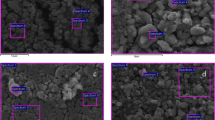Abstract
As an alternative to binder-based overlay of carbon powder on the current collector, the precursor sol may be carbonized directly on the current collector for the purpose of making supercapacitor electrodes. The disintegration of precursor sol into fine droplets prior to the deposition and subsequent removal of solvent from the deposited gel through lyophilization may enhance the internal surface area and the pore connectivity. This article presents the impedance spectroscopy analysis of such electrodes and reports the resistance to transport of electrolyte ions in such pore network through meaningful equivalent circuits. Neutral, alkaline, and acidic electrolytes were considered in this study. Multiple levels of hierarchy in the pore network are considered here to ascertain the extent of heterogeneity and branching in the pore structure. The electrodes from the binder-based overlay of carbon powder are studied here for comparison. The method of spray coating, followed by in situ carbonization seems to have produced a pore structure, which is less branched. The resistance to access the internal surface is more uniform over the entire domain for such electrodes. The equivalent series resistance was found significantly smaller for these electrodes.








Similar content being viewed by others
References
Sarangapani S, Tilak BV, Chen CP (1996) Materials for electrochemical capacitors: theoretical and experimental constraints. J Electrochem Soc 143:3791–3799
Simon P, Gogotsi Y (2008) Materials for electrochemical capacitors. Nature Mat 7(11):845–854. https://doi.org/10.1038/nmat2297
Miller JR, Simon P (2008) Electrochemical capacitors for energy management. Science 321(5889):651–652. https://doi.org/10.1126/science.1158736
Simon P, Gogotsi Y, Dunn B (2014) Where do batteries end and supercapacitors begin? Science 343:1210–1211
Conway BE (1999) Electrochemical supercapacitors: scientific fundamentals and technological applications. Kluwer Academic/Plenum Press, New York. https://doi.org/10.1007/978-1-4757-3058-6
Kötz R, Carlen M (2000) Principles and applications of electrochemical capacitors. Electrochim Acta 45(15-16):2483–2498. https://doi.org/10.1016/S0013-4686(00)00354-6
Burke A (2000) Ultracapacitors: why, how, and where is the technology. J Power Sources 91(1):37–50. https://doi.org/10.1016/S0378-7753(00)00485-7
Qu D, Shi H (1998) Studies of activated carbons used in double-layer capacitors. J Power Sources 74(1):99–107. https://doi.org/10.1016/S0378-7753(98)00038-X
Qu D (2001) The ac impedance studies for porous MnO2 cathode by means of modified transmission line model. J Power Sources 102(1-2):270–276. https://doi.org/10.1016/S0378-7753(01)00810-2
Frackowiak E, Béguin F (2001) Carbon materials for the electrochemical storage of energy in capacitors. Carbon 39(6):937–950. https://doi.org/10.1016/S0008-6223(00)00183-4
Frackowiak E, Meteneir K, BertagnaV BF (2000) Supercapacitor electrodes from multiwalled carbon nanotubes. Appl Phys Lett 77:2421–2423
Shi H (1996) Activated carbons and double layer capacitance. Electrochim Acta 41(10):1633–1639. https://doi.org/10.1016/0013-4686(95)00416-5
Gamby J, Taberna PL, Simon P, Fauvarque JF, Chesneau M (2001) Studies and characterisations of various activated carbons used for carbon/carbon supercapacitors. J Power Sources 101:109–116
Lin C, Ritter JA, Popov BN (1999) Correlation of double-layer capacitance with the pore structure of sol-gel derived carbon xerogels. J Electrochem Soc 146:3639–3643
Song HK, Hwang HY, Lee KH, Dao LH (2000) The effect of pore size distribution on the frequency dispersion of porous electrodes. Electrochim Acta 45(14):2241–2257. https://doi.org/10.1016/S0013-4686(99)00436-3
Taberna PL, Simon P, Fauvarque JF (2003) Electrochemical characteristics and impedance spectroscopy studies of carbon-carbon supercapacitors. J Electrochem Soc 150:A292–A300
Meyer ST, Pekala RW, Kaschmitter JL (1993) The Aerocapacitor: an electrochemical double-layer energy-storage device. J Electochem Soc 140:446–451
Niu CM, Sichel EK, Hoch R, Moy D, Tennet H (1997) High power electrochemical capacitors based on carbon nanotubes electrodes. Appl Phys Lett 70:1480–1482
Salitra G, Soffer A, Eliad L, Cohen Y, Aurbach D (2000) Carbon electrodes for double-layer capacitors I. Relations between ion and pore dimensions. J Electrochem Soc 147:2486–2493
Bruno M M, Cotella N G, Miras M C, Barbero C A (2005) Porous carbon–carbon composite replicated from a natural fibre. Chem Commun 0:5896–5898, 47, DOI: https://doi.org/10.1039/b511771b
Chimola J, Yushin G, Gogotsi Y, Portet C, Simon P, Taberna PL (2006) Anomalous increase in carbon capacitance at pore size less than 1 nanometer. Science 313(5794):1760–1763. https://doi.org/10.1126/science.1132195
Tamon H, Ishizaka H, Yamamoto T, Suzuki T (2000) Influence of freeze-drying conditions on the mesoporosity of organic gels as carbon precursors. Carbon38:1099–1105
Wu D, Fu R, Zhang S, Dresselhaus MS (2004) Dresselhaus G (2004) preparation of low-density aerogels by ambient pressure drying. Carbon 42(10):2033–2039. https://doi.org/10.1016/j.carbon.2004.04.003
Li J, Wang X, Wang Y, Huang Q, Dai C, Gamboa S, Sebastian PJ (2008) Structure and electrochemical properties of carbon aerogels synthesized at ambient temperatures as supercapacitors. J Non-Cryst Solids 354:19–24
Pröbstle H, Wiener M, Fricke J (2003) Carbon aerogels for electrochemical double layer capacitors. J Porous Mater 10:213–222
Kim J, Hwang SW, Hyun SH (2005) Preparation of carbon aerogel electrodes for supercapacitors and their electrochemical characteristics. J Mater Sci 40:725–731
Candy JP, Fouilloux P, Keddam M, Takenouti H (1981) The characterization of porous electrodes by impedance measurements. ElectrochimActa 26(8):1029–1034. https://doi.org/10.1016/0013-4686(81)85072-4
Keiser H, Beccu KD, Gutjahr MA (1976) Abschätzung der porenstruktur poröser elektroden aus impedanzmessungen. Electrochim Acta 21:539–543
Srinivasan V, Weidner J (1999) Mathematical modeling of electrochemical capacitors. J Electochem Soc 146(5):1650–1658. https://doi.org/10.1149/1.1391821
Lufrano F, Staiti P, Minutoli M (2003) Evaluation of nafion based double layer capacitors by electrochemical impedance spectroscopy. J Power Sources 124:314–320
Levie RD (1964) On porous electrodes in electrolyte solution-IV. Electrochim Acta 9(9):1231–1245. https://doi.org/10.1016/0013-4686(64)85015-5
Ganguly S, Chavhan MP (2016) An improved carbon electrode for electric double layer capacitor devices and a method of fabricating said improved carbon electrode Indian Patent:201631000006
Author information
Authors and Affiliations
Corresponding author
Rights and permissions
About this article
Cite this article
Chavhan, M.P., Pankaj & Ganguly, S. Charge transport in carbon electrodes made by electrospray of precursor sol and subsequent carbonization in situ. J Solid State Electrochem 22, 2149–2157 (2018). https://doi.org/10.1007/s10008-018-3903-5
Received:
Revised:
Accepted:
Published:
Issue Date:
DOI: https://doi.org/10.1007/s10008-018-3903-5




